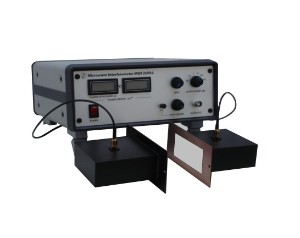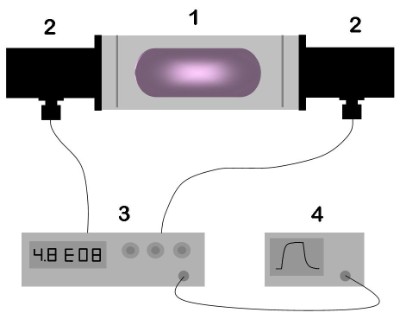S-band Microwave Interferometer MWI 2650-L
Application

This version of the microwave interferometer has been developed for measurements of extremely low density of free electrons in experiments with the dusty plasma on plasma installation like PKE Nefedov chamber. Design of the chamber allows application of interferometer circuit with low frequency of microwave radiation, which decreases low density limit for interferometric measurements.
Technical Data
Basics
Microwave interferometry technique is based on investigation of medium dielectric properties with help of electromagnetic waves. Since the dielectric constant of plasma is determined by plasma parameters, measurement of the propagation characteristics of microwaves passed the plasma gives a possibility to obtain plasma density.
Microwave interferometer measures phase shift of microwave radiation produced by plasma placed in the primary transmission path of the interferometer in respect to a phase of a radiation taken from an auxiliary transmission path of the interferometer and serving for the phase reference. In the low pressure plasma, this phase shift is essentially a function of plasma density only. Since the shift in phase can be calibrated, one has a continuous measurement of density between the critical density and the low limit of phase sensitivity of the interferometer. This technique is ideally suited to the observation of density as a function of time.
In the standard application, microwave interferometry deals with free space propagation of a microwave beam. It can not be realized when plasma and plasma chamber dimensions are comparable or less then the radiation wavelength. In this case plasma can be placed inside of waveguide with microwave radiation. Similar approach can be used for the present situation. Design of the PKE Nefedov chamber allows microwave radiation at frequency 2.6GHz to enter the chamber and propagate through it like in a waveguide. Plasma density measured in this situation is averaged over the plasma volume.
Features
The presented microwave interferometer MWI 2650 is a ready-to-use device which does not demand any special knowledge to put it into operation.
Absolute value of averaged plasma density can be observed on displays and taken from a BNC output after entering in the system a density calibration coefficient and preliminary setting the system on zero before plasma is on. The density calibration coefficient is determined by the chamber and plasma geometry and is constant for a given plasma chamber.
Installation and operation
Installation of the interferometer on the plasma chamber for measurements is shown on Fig. 4.1.
 |
1 - plasma chamber 2 - waveguide adaptors 3 - control unit 4 - oscilloscope/acquisition system Fig. 4.1 |
The microwave radiation is fed into the plasma chamber trough the opposite windows with help of two microwave adaptors, one is transmitting microwave radiation at 2.65 GHz in the plasma and the other serves for receiving of radiation passed the plasma. In case when only one window is available, one can use the circuit similar to that shown on Fig. 1.2 of MWI 2650. Microwave radiation coming into the plasma through one window is reflected from the opposite side of the chamber and come back trough the same window. The signal passed twice the plasma is received by the adaptor which is used both for transmission and for receiving and comes then via duplexer to the receiving unit.
Control unit contains digital displays for demonstration of value of density measured, calibrated BNC output of plasma density signal for an oscilloscope or acquisition system and control buttons for the following operations: calibration of the system by entering value of density calibration coefficient, fine adjusting to null, output filter with variable time constant.